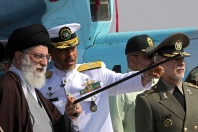Paying Tehran’s Bills
Sanctions relief will only empower Iran.
Jun 8, 2015, Vol. 20, No. 37 • By LEE SMITH/The Weekly Standard.
Even the Obama administration acknowledges that Iran is up to a lot of mischief in the Middle East. Tehran is engaged in a sectarian conflict from Lebanon to Syria and Iraq that has recently come to include Yemen as another active front. However, the White House continues to insist, against all evidence, that the clerical regime’s aggression won’t increase when it gets a huge cash infusion from sanctions relief and an immediate $30 to $50 billion bonus, when (or if) it signs the Joint Comprehensive Plan of Action, aka the nuclear deal.
NEWSCOM
According to Treasury Secretary Jacob Lew, Iran will almost surely use that money to improve its domestic economy. And besides, as Obama argued last month, “most of the destabilizing activity that Iran engages in is low-tech, low-cost activity.”
The numbers say otherwise. Staffan de Mistura, the U.N.’s Syria envoy, recently estimated that the war to prop up its Syrian ally is costing Iran $35 billion a year. That assessment is likely too high, but certainly of all Iran’s regional projects, keeping Bashar al-Assad’s regime afloat is the costliest. And that’s because it’s an occupation, says Fouad Hamdan, campaign director of Naame Shaam, an organization that keeps tabs on Iran’s war in Syria.
It’s a foreign occupation that affects Iran directly, because without control of territory in Syria, Iran loses its supply lines to Lebanon and Hezbollah, the Iranian regime’s most powerful deterrent against an Israeli strike on its nuclear program. Thus, says Hamdan, “the battle for Syria is a battle for the survival of the Iranian regime.”
Taylor Swift vs. Kanye West: How Listening to Your Clients Leads to Success
There was a time when the White House found it convenient to argue that the Syrian conflict was costly to Iran. When the war started there, rather than arm rebels to help topple Assad, the administration told its media surrogates that it was wisest to stand by as the war would bleed Iran. They were right about its potential to be a quagmire for Tehran. Now, sanctions relief, including the signing bonus, will enable Iran to bolster its support for Assad.
“Imagine Syria as a kind of Iranian province or governorate,” says Tony Badran, research fellow at the Foundation for Defense of Democracies. “Military defeats are boxing the Assad regime into an increasingly small region, basically now an enclave in western Syria along the Damascus-Homs corridor leading up to the Alawite homeland on the Mediterranean coast. Assad’s ability to survive is becoming almost entirely an Iranian responsibility. Facing a continuing war of attrition, the regime in Damascus has lost most of its ability for overland trade, with its only secure border being Lebanon. The Iranian responsibility is only increasing, as the Assad regime’s resources, and thereby its ability to maintain its patronage networks, pay salaries, and so on, shrinks or vanishes.”
Fouad Hamdan argues that the Assad regime is already well past that point. “Syria is broke,” he tells me. The various Syrian state institutions that the Obama White House says it wants to preserve even if Assad does fall are now almost entirely dependent on Iran. “Iran is pumping $500 million a month to the Syrian central bank that takes care of things like salaries and many of the internally displaced as well as Damascus and the coastal areas,” says Hamdan. “Iran spends maybe another half-billion a month for things like food and fuel, weapons and armaments, as well as the various militias now fighting in Syria, from the newly recruited Afghan Shiite militias, known as the Fatimeyun division, to Hezbollah.”
Naame Shaam (Persian for “Letter from Syria”) estimates that Iran’s Syria expenditures are $10 to $15 billion annually, roughly $1 to $1.2 billion a month. Hamdan, a 55-year-old Lebanese-German national, explains that his organization, which is made up of four Shiites (himself, a Syrian, and two Iranians) and was founded in 2014, gets most of its information from open source materials, especially the Iranian media. “The Iranian regime will boast about its activities openly,” he tells me. “Then maybe someone comes along and tells them it’s not a good idea to make that information public, so they remove it from the Internet.”
What Tehran is most keen to obscure, says Hamdan, is the fact that its war in Syria is an occupation. Syrian rebel fighters acknowledge that the Syrian army still exists in places, but, according to Hamdan, Iran’s Revolutionary Guard Corps (IRGC) is calling the shots. This was made plain in January when a high-level convoy targeted by Israel on the Syrian side of the Golan Heights included IRGC officers and Hezbollah fighters but no Syrian officials.
“In the chain of command,” says Hamdan, “Qassem Suleimani is on top, and the IRGC-Quds Force commander takes his orders directly from the supreme leader. Under him is Hossein Hamedani, who oversees IRGC operations in Syria. Then there’s the Iranian ambassador, various IRGC commanders, and Hezbollah commanders. Hezbollah does most of the training and takes on the most dangerous missions. Then there are other militias, like Iraqi and Afghan fighters, at the bottom.”
The Syrian regime’s most significant contributions to the war effort, says Hamdan, are its air force and the so-called National Defense Forces. These Iranian-trained civilian fighters have been combined with the paramilitary gangs known as the shabiha to replicate a Syrian version of the Basij, the paramilitary group created by the founder of the Islamic Republic, the Ayatollah Ruhollah Khomeini. Accordingly, almost nothing happens on the ground without the Iranians knowing about it or giving the direct orders, which includes war crimes and chemical weapons attacks. If the White House once boasted that it had rid Assad of his unconventional arsenal, the reality is that Iran has also crossed Obama’s red line against the use of chemical weapons.
“Iran doesn’t want to show it’s in control of Syria,” says Hamdan. “It needs Assad as a political cushion, especially now with charges that the Syrians are committing war crimes. Without the Assad regime, Iran would legally be seen as an occupying power, which would thereby have responsibilities to the people under occupation.”
It will be very hard for Iran to end its occupation of Syria. The Syrian border with Lebanon is Iran’s supply line to Hezbollah. If Iran loses that channel, an asset it has built up over 30 years with billions of dollars is isolated. The Iranians lose their ability to project power on the Israeli border as well as their most effective deterrent to protect their nuclear facilities against Jerusalem. Were Hezbollah to be deprived of its Iranian lifeline, it would be vulnerable not just to Israel—which has made clear over the last few weeks how dearly the party of God and all of Lebanon will pay in the next round of hostilities—but also to Lebanese (and Syrian) Sunnis looking to repay the blood debt Hezbollah has earned with its war in Syria.
Without Iranian assistance, Hezbollah will find itself drowning in a sea of Sunnis—from villagers in the Bekaa Valley to Islamist militants in the Palestinian refugee camps. Add to those numbers the 1.2 to 2 million Syrian refugees, the vast majority Sunni, now in Lebanon thanks to Iran and Hezbollah’s occupation of their homeland. There are also the battle-hardened Islamist groups that have been at war with Hezbollah for several years now, like Jabhat al-Nusra. As Nusra commander Abu Mohammed al-Jolani told an Arab news network last week, Hezbollah’s fate is tied to Assad’s. “The departure of the latter means the end of Hezbollah,” said Jolani. “The party has many enemies in Lebanon, and with the departure of Assad, their voice will rise against [Hezbollah].”
Iran’s regional position is built on sand. If it loses Syria, it may lose Hezbollah and leave its nuclear program vulnerable. What’s helping sustain Tehran’s strategy is the Obama administration. As the Iranians have kept Assad afloat, the White House has covered Iran’s flank in all four Arab capitals controlled by Tehran: Baghdad, where U.S. airstrikes supported an IRGC-led offensive on Tikrit; Beirut, where the administration shares intelligence with Hezbollah-controlled units of the Lebanese Armed Forces; Damascus, where the White House promised Iran that Assad was safe from U.S. strikes on Islamic State positions; and Sanaa, where American diplomats urge Saudi Arabia to seek a political solution rather than a military victory over the Iran-backed militias.
Sanctions relief will abet Iran’s regional goals. The signing bonus alone will cover the costs of Iran’s continued occupation of Syria for at least another year and tens of thousands more dead Syrian civilians.
**Lee Smith is a senior editor at The Weekly Standard.


















